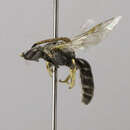mk
имиња во трошки


This species is part of the subgenus Sphecodogastra, treated as a genus in the review of McGinley (2003). Forages for pollen from the Onagraceae (evening primrose family). Because these flowers open early and late in the day, bee flight patterns are matalinal and crepuscular (at dawn and dusk) (McGinley 2003). Females plug the nest entrance when they leave to forage. This, combined with the restricted foraging period, may reduce brood parasitism (McGinley 2003). Like other bees of the Sphecodogastra group of Lasioglossum, these bees are generally solitary, but with some aspects of social behavior. Females return to their natal nest to overwinter, often with other females. This can involve 1-9 inseminated, overwintered females. (McGinley 2003). However only one overwintered female typically uses the nest for brood rearing and the others leave to establish their own nests (McGinley 2003). These bees generally excavate their nests in stabilized sand in open xeric areas (McGinley 2003). Nests occur in aggregations, with 15-20 nests per square meter in years of high population density, but only 10 nests in a few square meters in other years (McGinley 2003). Brood cells are unusual for halictines in that they are only partially (rather than fully) lined with a waxy secretion (McGinley 2003).The nest architecture consists of un-clusterd brood cells connected to the main burrow by short lateral tunnels (McGinley 2003). Species distribution: Lasioglossum lusorium is known from the Great Plains and western USA and Mexico south to Hildago State (McGinley 2003).Females fly from March to October, but primarily May through July. Males fly between April and October, but primarly June (McGinley 2003).